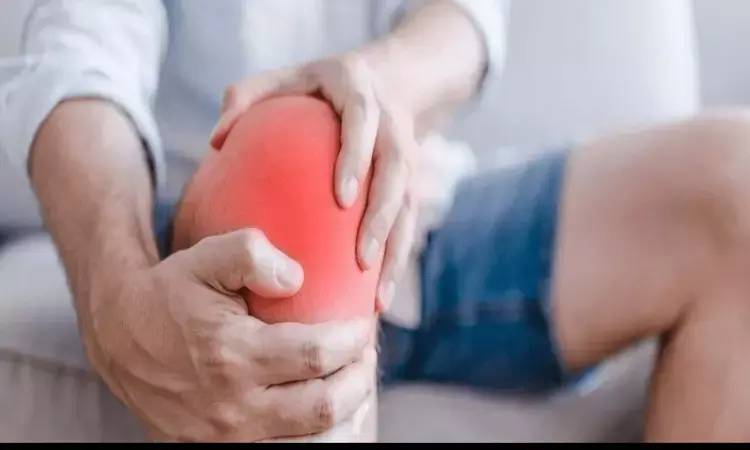- Home
- Medical news & Guidelines
- Anesthesiology
- Cardiology and CTVS
- Critical Care
- Dentistry
- Dermatology
- Diabetes and Endocrinology
- ENT
- Gastroenterology
- Medicine
- Nephrology
- Neurology
- Obstretics-Gynaecology
- Oncology
- Ophthalmology
- Orthopaedics
- Pediatrics-Neonatology
- Psychiatry
- Pulmonology
- Radiology
- Surgery
- Urology
- Laboratory Medicine
- Diet
- Nursing
- Paramedical
- Physiotherapy
- Health news
- Fact Check
- Bone Health Fact Check
- Brain Health Fact Check
- Cancer Related Fact Check
- Child Care Fact Check
- Dental and oral health fact check
- Diabetes and metabolic health fact check
- Diet and Nutrition Fact Check
- Eye and ENT Care Fact Check
- Fitness fact check
- Gut health fact check
- Heart health fact check
- Kidney health fact check
- Medical education fact check
- Men's health fact check
- Respiratory fact check
- Skin and hair care fact check
- Vaccine and Immunization fact check
- Women's health fact check
- AYUSH
- State News
- Andaman and Nicobar Islands
- Andhra Pradesh
- Arunachal Pradesh
- Assam
- Bihar
- Chandigarh
- Chattisgarh
- Dadra and Nagar Haveli
- Daman and Diu
- Delhi
- Goa
- Gujarat
- Haryana
- Himachal Pradesh
- Jammu & Kashmir
- Jharkhand
- Karnataka
- Kerala
- Ladakh
- Lakshadweep
- Madhya Pradesh
- Maharashtra
- Manipur
- Meghalaya
- Mizoram
- Nagaland
- Odisha
- Puducherry
- Punjab
- Rajasthan
- Sikkim
- Tamil Nadu
- Telangana
- Tripura
- Uttar Pradesh
- Uttrakhand
- West Bengal
- Medical Education
- Industry
Weight Cycling may lead to knee joint degeneration in obese individuals, Study says

According to recent research, it has been observed that weight cyclers had significantly greater increase in cartilage and bone‐marrow abnormalities over 4years than noncyclers, as published in the Obesity Journal.
Previous literature states that low-impact exercise is an ideal activity for people with joint degenerations. Low-impact activities include swimming, walking, and bicycling and all of these are considered less stressful for weight-bearing joints, especially the spine, hips, feet, knees, and ankles. However, there is seldom reports documented on the association of weight cycling with joint degeneration in obese individuals.
Hence, Gabby B. Joseph and associates from the Department of Radiology and Biomedical Imaging, University of California, San Francisco, San Francisco, California, USA conducted the present study with the aim to investigate the associations between weight cycling and knee joint degeneration in individuals with overweight or obesity with different patterns of weight change over 4 years.
The authors carried out a case-control study where they assessed a total of 2,271 individuals from the Osteoarthritis Initiative database. Linear regression models using annual BMI measurements over 4years were used to classify participants as weight cyclers or noncyclers.
3‐T magnetic resonance imaging was used to quantify knee cartilage transverse relaxation time (T2) and cartilage thickness annually over 4years in all subjects. Whole‐Organ Magnetic Resonance Imaging Scores (WORMS) were obtained for cartilage, meniscus, and bone‐marrow abnormalities in 958 subjects at baseline and at the 4‐year follow‐up.
The longitudinal differences in cartilage T2 and thickness between weight cyclers and noncyclers were assessed using general estimating equations, whereas the differences in WORMS outcomes were compared using general linear models.
The findings revealed that-
a. No significant differences in the rate of change of cartilage thickness or T2 were found between weight cyclers and noncyclers.
b. However, increases in maximum cartilage WORMS (P = 0.0025) and bone‐marrow abnormalities (P = 0.04) were significantly greater in weight cyclers than in noncyclers.
Therefore, the authors concluded that "although participants' intent for weight cycling in this study was unknown, weight cyclers had significantly greater increases in cartilage and bone‐marrow abnormalities over 4years than noncyclers, independent of weight gain and loss."
Dr. Nandita Mohan is a practicing pediatric dentist with more than 5 years of clinical work experience. Along with this, she is equally interested in keeping herself up to date about the latest developments in the field of medicine and dentistry which is the driving force for her to be in association with Medical Dialogues. She also has her name attached with many publications; both national and international. She has pursued her BDS from Rajiv Gandhi University of Health Sciences, Bangalore and later went to enter her dream specialty (MDS) in the Department of Pedodontics and Preventive Dentistry from Pt. B.D. Sharma University of Health Sciences. Through all the years of experience, her core interest in learning something new has never stopped. She can be contacted at editorial@medicaldialogues.in. Contact no. 011-43720751
Dr Kamal Kant Kohli-MBBS, DTCD- a chest specialist with more than 30 years of practice and a flair for writing clinical articles, Dr Kamal Kant Kohli joined Medical Dialogues as a Chief Editor of Medical News. Besides writing articles, as an editor, he proofreads and verifies all the medical content published on Medical Dialogues including those coming from journals, studies,medical conferences,guidelines etc. Email: drkohli@medicaldialogues.in. Contact no. 011-43720751


